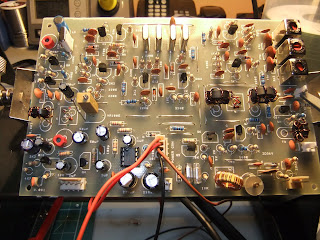http://www.cqbitx.blogspot.com/
This is a 20M version of the ever popular QRP design of the BITX. There is a lot of information on the BITX design available, originally designed and built by Ashhar Farhan, 2004. The project details are here:
http://www.phonestack.com/farhan/bitx.html.
There is now a wealth of knowledge on the various forms of this original design available at a Yahoo! group here:
http://groups.yahoo.com/group/BITX20/
I was looking for a good drive for my linear amp project and figured I might as well build this project and use this to test the linear!
Some pictures of my build follow, generally this was very straightforward, although I have built a different version of this before:



 Looking at the output of the PA with a constant drive from my audio generator, I've got about 70V pk-pk (the scope is connected using a x10 probe so it's 20V per division), that's about 8 watts. I would have expected a little better from a single IRF510 MOSFET. I used pk-pk voltage / 2 * .707 to give me RMS. Then squared the RMS and divided by 50 ohms.
Looking at the output of the PA with a constant drive from my audio generator, I've got about 70V pk-pk (the scope is connected using a x10 probe so it's 20V per division), that's about 8 watts. I would have expected a little better from a single IRF510 MOSFET. I used pk-pk voltage / 2 * .707 to give me RMS. Then squared the RMS and divided by 50 ohms.So in this case I have 70 / 2 = 35V peak. Multiplied by 0.707 = 24.745V RMS
P = E^2 / R, so thats 20.745^2 = 430.355 / 50 Ohms = 8.607 watts.

The MOSFET is being powered from an unregulated supply of about 26.26V DC which is also being regulated down to 13.8V for the main board and the relays on the PSU/Linear board.
I'm now planning to build a s-meter, a frequency readout and then case this project. The output is looking really clean, so once these extra bits are complete I need to stick it on the air and get some reports!
This kit cost me $40 US plus some very modest shipping costs from India. The kit contains the boards, relays, a hard to find transistor, cables, connectors, torroids, enameled wire plus much more. If you are looking for a cheap and easy way onto 20M, it doesn't get much better than this! All other components needed for the build I had here in the shack already.

No comments:
Post a Comment